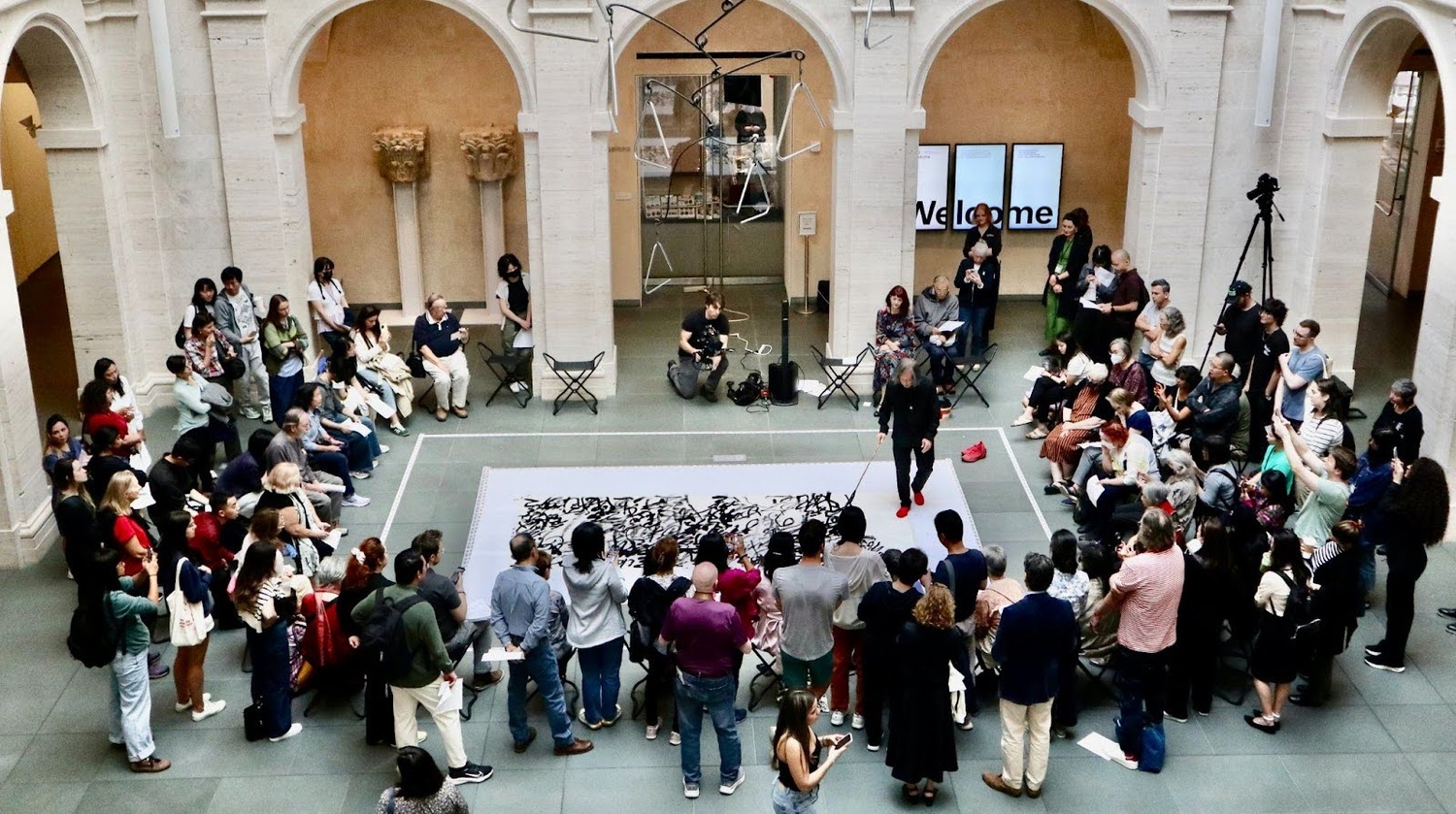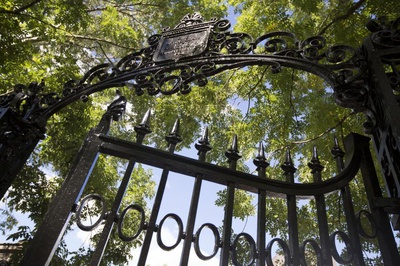
News
Nearly 200 Harvard Affiliates Rally on Widener Steps To Protest Arrest of Columbia Student

News
CPS Will Increase Staffing At Schools Receiving Kennedy-Longfellow Students

News
‘Feels Like Christmas’: Freshmen Revel in Annual Housing Day Festivities

News
Susan Wolf Delivers 2025 Mala Soloman Kamm Lecture in Ethics

News
Harvard Law School Students Pass Referendum Urging University To Divest From Israel
Live Calligraphy in the Courtyard: Chinese Artist Wang Dongling Performs ‘Flying Flowers and Scattered Snow’ at the Harvard Art Museums

“Flying Flowers and Scattered Snow” (飞花散雪), a title captured from an ancient seven-character Tang dynasty poem, was performed in the courtyard of the Harvard Art Museums by the Chinese calligraphy artist Wang Dongling on Sept. 27. The performance was sponsored by Shining (Christina) Sun, a Ph.D. student at Harvard’s Graduate School of Design.
Wang Dongling was born in China’s Jiangsu province in 1945 and trained in fine art during college, when he was interrupted by the Cultural Revolution of China in 1966 — during this time, he wrote political slogans on large-character posters. During the Avant-Garde movement of the 1980s, Wang began to experiment with using a mop-sized brush to write stand-alone characters. Wang then came to the U.S. as a visiting professor at Minnesota University from 1989 to 1991, where he was able to teach Chinese calligraphy while also experimenting with Western art forms. Wang is now a professor of calligraphy and director of the Modern Calligraphy Research Center at the China Academy of Art in Hangzhou.
The three poems Wang brought to the Harvard Art Museums were Su Dongpo’s “West Lake Poems” from the Song dynasty, closely tied to Wang’s second hometown in Hangzhou. The title of the performance, “Flying Flowers and Scattered Snow,” is also taken from a Tang dynasty poem to describe the chaos and dynamism of his calligraphy.
The performance opened with remarks by Dr. Sarah Laursen, the curator of Chinese Art at the Harvard Art Museums. Laursen introduced the performance as a “chaotic script of liberty” (草书), drawing upon “an ancient text and brush painting traditions to create a large gestural work focused on the exalted West Lake poems of Su Dongpo.”
Attendees standing on the first and second floors peered into the Calderwood Courtyard to watch Wang stepping on the gigantic white sheet of xuan paper with a large broom-like brush. The characters tangled with each other, creating a distinguished, barely legible style.
Wilson Wang, a first-year graduate student at the Regional Studies East Asian program, commented on the writing style of the artist.
“It’s very mesmerizing because the characters, they’re really not legible, so you kind of just go with the strokes and the flow. So I really saw it more as some form of painting, essentially, instead of calligraphy.”
The performance embraces both traditional Chinese culture, featuring ancient Song poetry, while also innovating the modern techniques of calligraphy writing with combination of Western abstract art in an encounterance between East and West.
“It’s nostalgic but it brings something completely new and different,” Wang said, as a student from China.
The courtyard space of the performance caught the audience’s attention and played a huge role in the audience’s live experience.
Isabel McWilliams, a Ph.D. candidate in the History of Art and Architecture with a focus on medieval Chinese art, called the performance “hypnotic.”
“He sort of brought me into a trance,” McWilliams said. “I thought that the movement very much encapsulated the title, which was ‘Flying Flowers and Scattered Snow,’ and you definitely got that impression from the continuity and the bits of punctuation.”
What was particularly special about the live performance was the process of being in the moment with the artist at the moment of his creation.
“It’s as much a creative process as it is like a finished work at the end,” McWilliams said.
The calligraphy performance was not only an artistic experience, but also a cross-cultural one. The event organizer Shining (Christina) Sun had initially conceived of the event two years ago when she met Wang in Hangzhou.
“Even for people who can read Chinese characters, they get the idea of it. They get the gesture, the emotion, through this action painting. I think it's a way to get to a more interesting traditional art,” Sun said.
—Staff writer Dailan Xu can be reached at dailan.xu@thecrimson.com . Follow her on X at @Dailansusie.
Want to keep up with breaking news? Subscribe to our email newsletter.
From Our Advertisers

Over 300+ courses at prestigious colleges and universities in the US and UK are at your disposal.

With innovative financial tools combined with financial education, Collegiate empowers students to take control of their finances and build confidence in their money management skills.

Serve as a proctor for Harvard Summer School (HSS) students, either in the Secondary School Program (SSP), General Program (GP), or Pre-College Program.

With an increasingly competitive Law School admissions process, it's important to understand what makes an applicant stand out.

Welcome to your one-stop gifting destination for men and women—it's like your neighborhood holiday shop, but way cooler.

Admit Expert is a premium MBA admissions consulting company, helping candidates secure admission to top B-schools across the globe with significant scholarships.
